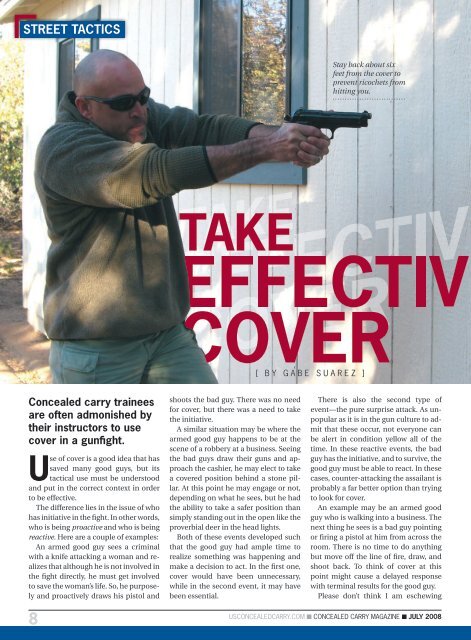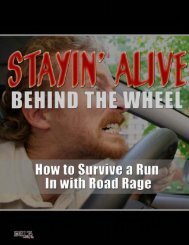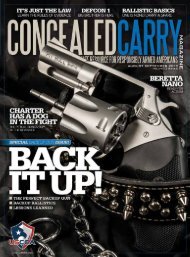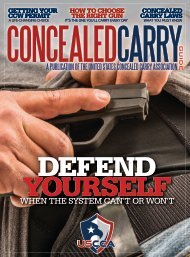Download This Issue - US Concealed Carry
Download This Issue - US Concealed Carry
Download This Issue - US Concealed Carry
You also want an ePaper? Increase the reach of your titles
YUMPU automatically turns print PDFs into web optimized ePapers that Google loves.
STREET TACTICS<br />
Stay back about six<br />
feet from the cover to<br />
prevent ricochets from<br />
hitting you.<br />
[ B Y G A B E S U A R E Z ]<br />
<strong>Concealed</strong> carry trainees<br />
are often admonished by<br />
their instructors to use<br />
cover in a gunfight.<br />
Use of cover is a good idea that has<br />
saved many good guys, but its<br />
tactical use must be understood<br />
and put in the correct context in order<br />
to be effective.<br />
The difference lies in the issue of who<br />
has initiative in the fight. In other words,<br />
who is being proactive and who is being<br />
reactive. Here are a couple of examples:<br />
An armed good guy sees a criminal<br />
with a knife attacking a woman and realizes<br />
that although he is not involved in<br />
the fight directly, he must get involved<br />
to save the woman’s life. So, he purposely<br />
and proactively draws his pistol and<br />
shoots the bad guy. There was no need<br />
for cover, but there was a need to take<br />
the initiative.<br />
A similar situation may be where the<br />
armed good guy happens to be at the<br />
scene of a robbery at a business. Seeing<br />
the bad guys draw their guns and approach<br />
the cashier, he may elect to take<br />
a covered position behind a stone pillar.<br />
At this point he may engage or not,<br />
depending on what he sees, but he had<br />
the ability to take a safer position than<br />
simply standing out in the open like the<br />
proverbial deer in the head lights.<br />
Both of these events developed such<br />
that the good guy had ample time to<br />
realize something was happening and<br />
make a decision to act. In the first one,<br />
cover would have been unnecessary,<br />
while in the second event, it may have<br />
been essential.<br />
There is also the second type of<br />
event—the pure surprise attack. As unpopular<br />
as it is in the gun culture to admit<br />
that these occur, not everyone can<br />
be alert in condition yellow all of the<br />
time. In these reactive events, the bad<br />
guy has the initiative, and to survive, the<br />
good guy must be able to react. In these<br />
cases, counter-attacking the assailant is<br />
probably a far better option than trying<br />
to look for cover.<br />
An example may be an armed good<br />
guy who is walking into a business. The<br />
next thing he sees is a bad guy pointing<br />
or firing a pistol at him from across the<br />
room. There is no time to do anything<br />
but move off the line of fire, draw, and<br />
shoot back. To think of cover at this<br />
point might cause a delayed response<br />
with terminal results for the good guy.<br />
Please don’t think I am eschewing<br />
<br />
<strong>US</strong>CONCEALEDCARRY.COM n CONCEALED CARRY MAGAZINE n JULY 2008
















